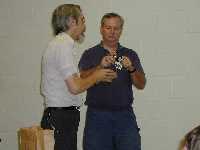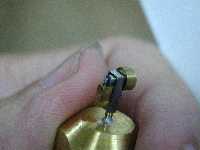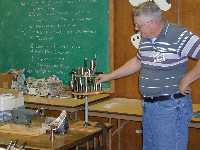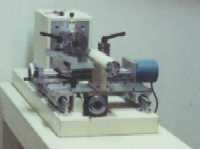

Volume 4, Number 11 - November 1999
Journal of the Home Metal Shop Club of Houston,
President - Keith Mitchell, V. Pres.- John Lilly, Treasurer - Gordon
Lawson, Secretary - Dean Eicher
Editor - Keith Mitchell Hm (281) 391-2406 Wk (713) 215-8123 Email kmitchl@wt.net
Membership Information Membership is open to all those interested in machining metal and tinkering with machines. The purpose of the club is to provide a forum for the exchanging of ideas and information. This includes, to a large degree, education in the art of machine tools and practices. There is a severe shortage of written information that a beginning hobbyist can use. This makes an organization such as this even more important. For membership information and forms, call Keith Mitchell at the phone numbers shown at the above.
Notes from the President
By: Keith Mitchell
I though Tom Moore's presentation in the last meeting was excellent. Tom did an excellent job of demonstrating his tailstock tooling. Tom has been a big part of our knowledge base. He has shown a lot of really nice stuff he has made over a number of years. The presentation at the November meeting will be by Ron Blair on adapting variable frequency drives to machinery. Ron will describe how to bring the power source for your 1940's vintage machine into the 21st century.
I'm interested in setting up a small home foundry to pour Aluminum and brass. Step 1 is to design a furnace. Gordon Lawson and I have been sharing ideas. If anyone else is interested please contact either Gordon or I. By making this a joint effort perhaps we can reduce the number if iterations required to be successful.
At the last meeting we agreed to move our meeting location from the Oak Forest Library to the Collier Library. I hope this is not a hardship on anyone, however, we continue to gain membership and have outgrown the present location. I'm sure we'll miss the elephant and dog. If you don't know what I'm talking about look back at some of our past photos from meetings. John Korman is responsible for the entry in the latest edition of Home Shop Machinist. I have sent an update to revise the meeting location.
This month's newsletter contains an excellent article by Jan Rowland on CNC. We worked on presentations in the last meeting. We got a number of suggestions but not many volunteers. Give some thought to what you might present which would be of interest. Presentations do not need to be from the list we developed during the last meeting. Be proactive, volunteer. We need some help there. See you the 20 th.
October Meeting Minutes
By: Dean Eicher
Chips Meeting - 1:00 P.M. September 18, 1999, Oak Forrest Library
Attendance - 34, Three first time attendees
In the Chips Meeting the following activities took place.
1. New Meeting Location - A motion to change the meeting location from
the Oak Forrest Library to the Collier Library carried. A tentative date
to commence meeting at the Collier Library would be for the December 18,
1999 meeting.
2. Presentation Sign Up Schedule - The following people volunteered
to present topics of interest at club meetings: December, J. D. Wise and
Keith Mitchell will talk about workholding, January, John Hoff will talk
about boring and fly-cutting, February, Tom Moore will talk about the Machinist's
Handbook, and for March, George Carlson will talk about machine repair.
Tom Moore also agreed to talk about cross slide tooling and sharpening
tooling at later meetings.
3. Feature Presentation - Tom Moore talked about lathe tailstock tooling.
Starting with center drills and countersinks, Tom continued with centers
and their uses. His center tool collection consisted of: a half center,
a square center, a ball-bearing center, and a wood center, in addition
to the standard hard center and soft center commonly furnished with a lathe.
Tom brought an adapter tool which was threaded the same as his lathe headstock
spindle at one end and had a Morse taper shank to fit the tailstock on
the other end. He also had a depth gauge, die holders, floating reamer
holders and extreme pressure grease for lubricating moving parts against
stationary centers. Tom also shared his idea of every tenth day building
shop tooling.
4. Tom Moore - brought some scissors and hemostats for sale by the
locomotive club.
5. J. D. Wise - talked about watchmakers. He said they mostly make
watch repair parts and tools, not watches. A watchmaker's skills are similar
to those of a regular machinist, and to demonstrate, he showed an oscillating
cylinder type engine, which he ran off a small hand operated air compressor.
The engine's largest dimension was approximately 1/4 inch. J. D. also talked
about carbide gravers.
6. George Carlson - showed his aluminum dominoes.
7. Keith Mitchell - brought some pens he made and discussed materials
available for the pen bodies. Keith also brought a set of plans for a compressed
air powered swarf vacuum. He showed several iterations of the pickup and
nozzle assembly he made.
8. Vance Burns - talked about using the nozzle of an air blower to
increase the draft up a chimney or exhaust pipe to raise the fire temperature.
9. Jan Rowland - brought two Napco Fastener charts


Left - J. D. Wise (left) and Keith Mitchell (right)
operating tinypower engine constructed by J.D. from a bicycle pump
air supply. Right - Close up of engine
 Tom
Moore with his Tailstock Tooling Carousel.
Tom
Moore with his Tailstock Tooling Carousel.
The HMSC Newsletter space-budget precludes preface and some philosophical palaver which might elsewise be of use. So, I will get right to it:
All the readers hereof realize that milling-machines and lathes have basically two axis of operation, "X", for East-West, and "Y" for North-South, and mills have also "Z" for quill up-down. These movements have been primarily done via lead-screws, turned by handwheels or crank-handles in manual-only machines, or motors under electronic or computer control in "NC" and "CNC" machines. Obviously the pitch of these lead-screws must be precision-rolled and/or ground, usually with some decimal relationship to the units of measure being used, such as, for example, 0.100" per turn. Or, as is more common, perhaps, with "Bridgeports", 0.200" per turn! Professionally-manufactured CNC machines such as Bridgeport generally have preloaded ball-screws for lead-screws. For the less-ambitious home-machinist, fine ACME and ball-screws can be had from more than one good source [see listing below], and for many applications, are quite adequate.
Next, a means of turning these screws must be considered, and there are basically two ways this is done: 1) "open-loop", or 2) "closed-loop". The loop referred to here is an electromechanical one wherein a "loop" is made up of the connection from whatever controller (computer) and the motor to be controlled, "closed" by bringing a connection back from that motor's shaft-encoder to the computer. In that closed-loop situation, the computer "tells" the motor how much to turn and in which direction, and the shaft-encoder very-accurately measures the movement "on the fly," and sends a message back via a "feedback connection" that the movement is done, and if correctly, whereupon the computer stops sending its "move-signal". Clearly, with this system, if something impedes the movement, say, a harder-than-expected chunk of material, or a dull cutting-tool, the computer will "keep telling" the motor to move until it does, or dies-trying!
The "open-loop" system is one where that loop is not "closed", but where the computer sends commands to a stepper-motor system which makes a stepper-motor connected to the lead-screw in question "step" whatever number of steps in the desired direction. There is no "feedback". The computer continues its program, as if it assumes the desired movement has been made. The earlier "NC" and some early "CNC" (Computer-Numerical Control) systems had only stepper-motors. But engineering and experience had them working very reliably, though this writer understands that Bridgeport now uses "closed loop servo systems".
There is a point to these two paragraphs: A reasonably-skilled home-shop machinist can build his own "CNC" gear which can operate readily as well as his machining skill, using only stepper-motors and store-bought drives ("electronics") and a "PC" which nearly everyone has, nowadays-right? Several firms [see list below] make excellent stepper-motors of various torques, and some might argue some firms do it better than others, etc. But the Superior Electric division (once just Superior Electric, Inc.) of Warner/Dana is the "granddaddy" of stepper-motor manufacture, and they now also offer quite a number of "translator-drives" for their various motors, some with quite powerful computer brains built-in, but this writer is not familiar with these "smart ones", at least at this time. One can therefore figure which size/power motor he needs for turning the lead-screws of a given design, pick the stepper-motors per mechanical-engineering discipline, select a drive with power-supply for those, connect same to the LPT-1 port of even an ancient '286 monochrome computer running only DOS and GWBASIC (i.e., no Windows-NN necessary!), and have a machine making amazing things in a few hours. Right.
It is almost industry-standard that all stepper-motors step 200 times per revolution, although some are made with 400 steps per revolution, and some small ones for such as computer floppy-drives have different step-angles, yet. Most of those for machine-tool use are the 200 steps/turn type, or 1.8°/step. I built two small CNC lathes for a specific application, using 0.100"/turn screws; thus, one step is 1/200 of 1/10", or 0.0005". In other words, two steps=0.001". This is convenient for programming, as the Y- stepping-into the diameter of the turning stock-removes 0.001" of the diameter for each single step. That is, to cut 1.000" dia. down to 0.900", I might send 100 pulses to the Y-motor-driver, plunging the tool 0.05" into the rotating workpiece. Using the same pitch of screw, the length of the moves on the X-axis is counted in "half-mils" or steps of 5-tenths, each. That is, to move that 0.100" of length, the crossfeed must move 200 steps "left", or, toward the headstock. There is also "half-stepping" where a 200-step motor can be made to step 400 half-steps per turn, but we won't get into all that here! Another detail in this regard some readers may have noticed in the literature is "microstepping" where many hundreds or even thousands of "micro-steps" may be made per-turn, but for home-brew, there is hardly any point in even mentioning this topic except to say, "IGNORE!"
Due to electrical engineering considerations beyond the point of this
little article here, stepper-motors such as we discuss here for machine-tools
run on very low DC voltages and relatively high DC currents, at least electronically-speaking.
That is, for a fist-sized motor to run a fan, say, on 120 V., the current
would be less than one ampere. But for a stepper-motor about that same
size, you would be talking less than 6 volts and several amperes. A "Size-34"
motor might want, say, 3 VDC at 4 A. This is quite a chunk of current for
rapid switch-on/off, to make stepping-rate sufficient for rapid-traverse
of an acceptable speed, so the electronics which drive machine-tool stepper-motors
are relatively sophisticated and must be very well engineered and built.
For steppers as small as size-34 and below, home-brew drives are plausible
if the builder has years of experience with things-electronics, and at
least months of tinkering and reading about the intricacies of stepper-motors.
Inductance and semiconductors require discipline! But the manufacturers
seem to realize this, so, to sell their goods, they offer pre-packaged
electronics which make this a moot point.

Here I show a block-diagram of a hookup which would be plausible for the non-electronic type who otherwise can do fine machine-work, and has therefore the discipline of workmanship to read "accompanying literature with care". These days, the "PC" has advanced so rapidly that old ones suitable for running small machines in the shop can be had for $100 or less. I have two ancient ones I got for FREE, as the prior owner said he'd have had to PAY the new-computer provider to take them away! They all have a "line-printer port", the "LPT-1". Since it is clear a computer intended to run a machine in a shop would have no need for a printer, that connection is therefore available for running the machine! To make a potentially-long story shorter, there are 8 lines in the 25 of the printer port which are the data lines. Software can make any or all of these in any pattern go on or go off (present 5.0 VDC or 0 VDC). A stepper-motor translator/driver circuit has at least two inputs per motor which make the motor "step" CW or CCW, either of two ways: One way (I prefer!) is that ONE of these two lines pulses "HI" (to 5VDC) and "LO" (0 VDC) again to make a step in the CW direction, and the OTHER line does the same to make a step in the CCW direction. The opposing line remains "LO" when either is stepping.
The other way is where one line is direction, meaning it is "HI" for CW moves, and "LO" for CCW moves, and the other line pulses for either direction, the number of times desired in that direction. This second system is a bit more cumbersome in my opinion; thus, as said, I prefer the system described in the previous paragraph.
I have seen some machines on the bench such as small floppy-disk drives with tiny 1" dia. steppers, and these can turn a disk, but only if not too dusty! I.e., very little torque! I have built small plotters, one slightly smaller than the PCB-drill I brought to the June HMSC meeting, with "MO-61" motors (Size-23), and the lathes with Size-34 motors. I am presently building two new lathes with a new series of "KM" size-34 motors, which have at least twice the torque of the exact-same-size older MO-92 motors (and nearly that much more $$-per!). I have built one HUGE "X-Y table" with a 31/2 hp. 400 Hz.-3-Ø router-motor on a carriage - $thousands of preloaded ball-screws and Thomson Products linear ball-bearings and shaft-ways - now at work in England (since '86!). That monster had a Size-42 Y-motor, and a 1.1 hp. X-motor. This last one was about the size of a "tool motor" of that same hp. It cost much, much more, and its electronics package cost twice-again as much, alone! With care in fabrication and assembly, a "stepper-only system" can work precisely and reliably, perform an amazing range of tasks, even if the computer, having no feedback via that closed-loop, has no clue whether its commands have been properly made before going on to the next line in the program!
Programming? I have only used GWBASIC for what I do. A very simple "ASM-86 machine-code patch" is used to pulse the desired line(s) of those 8 of the LPT-1, when CALLed by a line in a FOR-NEXT loop. Sounds esoteric? Actually, easier to learn than "G-code". A couple years back, I bought a book on G-code, and after I had read enough to kinda have an idea of what it was about, I realized I had no use for it, as I am not a professional machinist with four or more Bridgeports all earning a living with eight or ten union-machinists buzzing about in a large shop. So, I am content with primitive "do it myself" programming, using very general-purpose BASIC. I would be pleased to explain how this works over coffee to anyone who reminds me to bring a pad and pencil!
01/08/99

Home Brew CNC Lathe |

Home brew CNC Lathe in operation making Organ knob |
Ball-Screw Sources:
Ball Screws & Acutuators Co., Inc.
3616 Snell Avenue
San Jose, CA 95136-1305
(800) 882-8857
Rolled, precision-rolled, ground ball-, Acme, and V-thread; single and double pre-load ball-nuts, Turcite "supernuts", and bronze nuts. Sizes from 1/8" dia to 4" dia., many pitches. Also metric. Also some other linear products.
Noll Inc.
390 Buckley Road
San Luis Obispo, CA 93401
(805)543-3602
Precision rolled Acme screws in SS. Also metric. Turcite lead-nuts, both plain and pre-load.
Kerk Motion Products, Inc.
1 Kerk Drive
Hollis, NH 03049-6442
(603) 465-7227
Ditto
THK Co., Ltd., Tokyo, Japan
THK America, Inc.
1300 Landmeir Road
Elk Grove Village, IL 60007
(312) 956-6188
Ball screws, ball-splines, linear ways and bearings. Very precision, expensive.
ROTON
(800) 467-6866
Rolled Acme, high-lead, splines, ballscrews, worms and accy.
Thomson Industries, Inc.
2 Channel Drive
Port Washington, NY 11050
(800) 554 THOMSON
Linear Bearings
Stepper-Motor sources:
Superior Electric Div. of Warner-Dana
383 Middle Street
Bristol, CT 06010
(860) 585-4500
(800) 787-3532
DANA Warner Electric Motors and Controls Division
Division Sales Office
640 Avis Drive, Suite 200
Ann Arbor, MI 48108
SIGMA MOTION CONTROL
Sigma Instruments, Inc.
Braintree, MA 02184
(617) 843-5000
KOLLMORGEN Motion Technologies Group
23011 Moulton Parkway
Unit H5
Laguna Hills, CA 92653
(800) 77-SERVO
Precision Mechanical Components:
(of every description, all precision and $$!!)
W.M. BERG, INC.
499 Ocean Avenue
East Rockaway, NY 11518
www.wmberg.com
(800) 232-BERG
Machinery Moves

Machine prepared fro move. Head rotated 180 degrees and supported from table. Table lowered and centered. |

A tilt bed trailer makes loading much simpler. Making the transition from the concrete is assisted by some lumber to help with the change in elevation. Note the winches connected top and bottom. |

The transition to the trailer bed is complete. Two pieces of 3/8" X 2" flat bar on the trailer bed help to skid the machine up. |

Machine is in position and ready for tiedown. Machine must be far enough forward to put weight on the hitch to make trailer tow properly. Flat bar is removed from under machine and machine is chained and strapped in place. |
